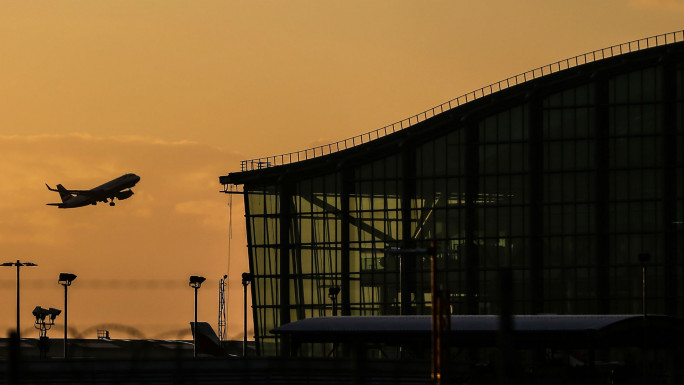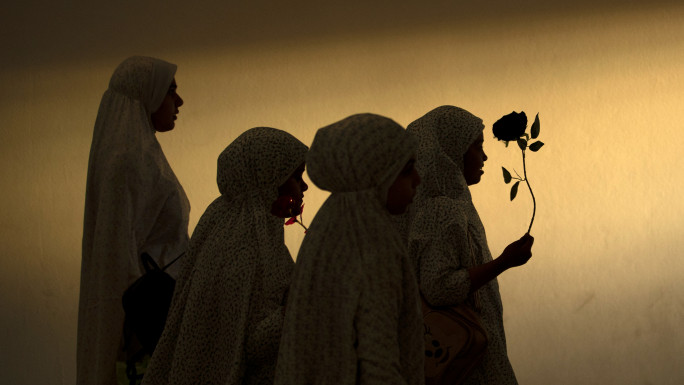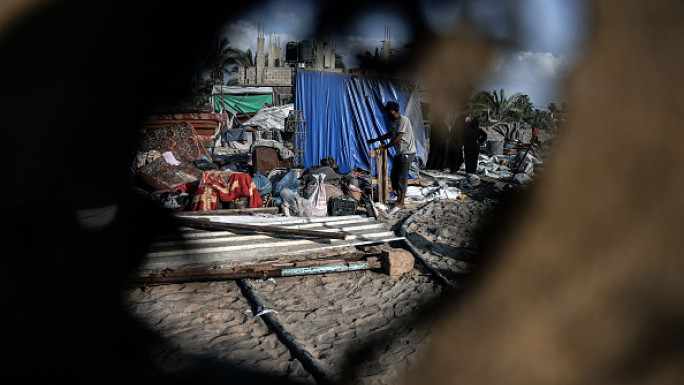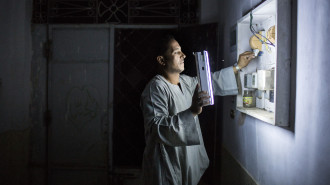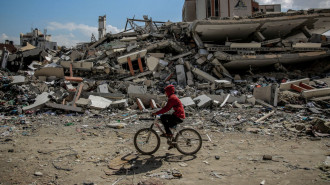
From fresh figs to garbage: Israeli settler expansion turns the West Bank into a dumping ground

Tulkarem, the fifth largest city in the West Bank, is known for its citrus fruits, its university – and the regular clashes between the Israeli army and young Palestinians.
But another war is being waged in silence: its 90,000 inhabitants are dying of cancer five times more often than other Palestinians.
The culprit: an Israeli industrial zone ironically named Nitzanei Shalom ("seeds of peace") and known by locals as Geshuri, after one of the largest companies settled there.
An oppressive presence, it was set up in 1982 on confiscated land at the town’s edge. Grey and menacing, eleven chemical plants stand between walls topped with barbed wire and surveillance towers.
“We have two problems here, the Israeli occupation and Geshuri," sighs Ahed Zanabet, the local manager of the Palestinian Agricultural Relief (PARC), a Palestinian environmental NGO which helps farmers in the whole West Bank survive amidst the occupation.
“Chemical waste from Geshuri flows untreated into Palestinian agricultural areas," Ahed explains to The New Arab.
From paint to pesticides over liquefied natural gas (LNG) and cleaning gas pipes with pressurised water, the industries in Nitzanei Shalom are all more toxic than the others.
"We have a high incidence of lung cancer due to air pollution and skin diseases due to gas residues. Our springs are also polluted by wastewater from the settlements," Ahed adds.
Farmers are forced to use greenhouses to protect their fruit and vegetables, but even these are quickly covered with a layer of toxic dust.
"There's nothing we can do to stop Geshuri, except help the farmers whose land is contaminated," he says with resignation.
Palestinian town of Tulkarem
Social and environmental dumping
The Geshuri factory was moved from the Israeli town of Netanya to Tulkarem in 1982 following complaints from Israeli residents about pollution — and so it was left to the Palestinians to suffer.
As the industrial park is located along the "green line" at the border, its toxic emissions can quickly be blown by the wind towards Israel.
"When the wind blows from east to west, the industries stop working to ensure they do not pollute the Israelis," claims Abeer al-Butmeh, environmental engineer and coordinator of the Palestinian environmental association PENGON-Friends of the Earth. Local farmers and inhabitants back Abeer's claim.
The industries employ mostly Palestinian workers from the West Bank.
"They are a cheap source of labour and suffer from numerous accidents and respiratory illnesses," she explains.
After a long strike, they managed to obtain the Israeli minimum wage in 2016, but their working conditions haven't changed, and inhabitants are still desperate.
"We've tried to mobilise on several occasions, organising campaigns, demonstrations and field visits for international missions and activists," Abeer tells The New Arab. "But nothing has changed."
Sacrificed zones
According to Abeer, Nitzanei Shalom is one of 60 Israeli industrial zones in the occupied West Bank (HRW lists 20) and some benefit foreign multinationals — contrary to international law, which considers settlements illegal.
"In Israel, companies have to comply with environmental and social standards, which costs them money. So they transfer their polluting factories to the West Bank, where they comply with minimal or no standards," the activist explains.
The Israeli human rights organisation Btselem calls these industrial areas "sacrificed zones": a kind of mini-tax haven where arbitrariness reigns.
This social and environmental dumping is repeated throughout the West Bank, polluted by 145 Israeli settlements – both industrial and residential.
In 2017, they discharged 19 million cubic metres of wastewater onto Palestinian land per year — a figure that is rising steadily as Israel continues to build settlements at a frenetic pace.
The New Arab was able to observe illegal wastewater and garbage dumps from settlers all over the West Bank, in Wadi Fukin, near Bethlehem, as well as in Bil'in, west of Ramallah.
One hour north of Ramallah, Selfit is one such “sacrificed area”. The Palestinian town is encircled by the huge Ariel settlement block, founded in 1978.
It is home to almost 40,000 settlers on over 120,000 km2 of confiscated Palestinian land, as well as an industrial zone called Barkan. Its 120 factories employ 5,000 Palestinian workers to produce textiles, metals and plastics.
A little further on, in a valley surrounded by Mediterranean scrubland and olive groves, flows the Matwi — the main source of drinking water for Selfit's 12,000 Palestinian inhabitants.
According to Salfit municipality’s calculations, the surrounding settlements produce 900,000 m3 of wastewater per day. A big part – or all of it – flows a few metres away from the al-Matwi spring.
of Burkan and Ariel
"The settlements produce a lot of waste. Some of it is treated, but their treatment plant, if it still works only covers a fraction of it. When it rains, the sludge contaminates our river," laments Ashraf Zuhod, Selfit's Director of Waste and Environmental Management and author of a doctoral thesis on groundwater quality in the West Bank (in progress).
The municipality of Ariel denied responsibility for the pollution and accused Palestinians of contaminating their land, claiming that all of its waste was being treated.
Btselem, on the other hand, claims that Ariel’s wastewater treatment plant ceased functioning altogether in 2008.
The Israeli occupation: A damned obstacle to waste treatment
"All the land near Wadi al Matwi is agricultural. The spring was beautiful and pure when I was a child, and we used to go there to pick fresh figs. Today, it smells like garbage," Ashraf comments.
Studies by the municipality and universities reveal traces of faecal matter, as well as nitrates from the wastewater of the settlements.
Ashraf draws up a long list of ailments afflicting the inhabitants: "Humans are suffering from the increase in leukaemia, digestive system and prostate cancers, which are caused by industrial pollution," he explains.
In a recent study, 46.1% of Selfit residents surveyed claimed to suffer from diarrhoea and 34.8% from vomiting.
Mosquitoes and wild boar proliferate, spreading disease, killing herds and destroying ancient ecosystems.
Wadi Fukin, observes the Betar Illit settlers' dumping ground
For the municipal employee, the lack of Palestinian infrastructure is also to blame, and he is quick to criticise the low environmental standards adopted by the Palestinian Authority.
"Most towns here have only sceptic tanks and no real wastewater and waste treatment solutions," he criticises.
The same goes for solid waste: several Palestinian illegal dumps contaminate the land and water, like the one The New Arab witnessed in nearby Farkha, on the banks of the Matwi River.
However, in Selfit as elsewhere, the main problem remains the Israeli occupation. The town council of Selfit began a project to build a wastewater treatment plant in the 1990s, but the Israeli authorities have stopped it twice.
It was only in 2019 that it could be built, with 7.5 million euros of German funding.
"And we have to pay a lot of money to decontaminate our water and treat al Matwi spring," Ashraf complains, a fact confirmed by a study.
regularly fire on Palestinian civilians
In Farkha, the waste disposal project was also refused by the Israeli authorities, which control 60% of the West Bank (in Zone C), hence the farmers' recourse to unauthorised dumps.
This makes it difficult for Palestinians to manage their waste, and that of the settlers occupying their land, under an increasingly violent occupation.
In addition to the 39,000+ victims in Gaza, more than 560 Palestinians have been killed in the West Bank since October 7.
Tulkarem is paying a high price, as the Israeli army regularly invades the Nur Shams refugee camp, reaping destruction and killing dozens of civilians and fighters.
Between the pollution and the raids, there is no end to the suffering in sight.
Philippe Pernot is a French-German photojournalist living in Beirut. Covering anarchist, environmentalist, and queer social movements, he is now the Lebanon correspondent for Frankfurter Rundschau and an editor for various international media
Follow him on Twitter: @PhilippePernot7





![Children in Gaza are getting white hair due to stress and trauma [The New Arab/Supplied]](/sites/default/files/styles/image_684x385/public/2024-09/gaza-white%20hair-supplied.jpg?h=05074998&itok=zfsWeT8P)
